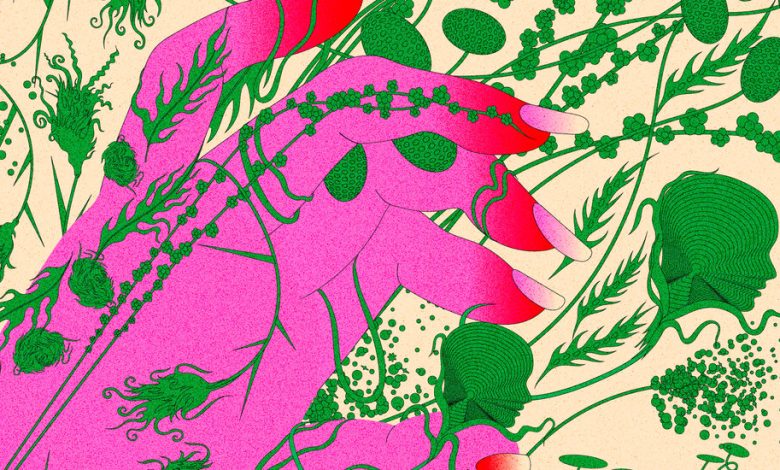Why Weeds Are Worth Reconsidering

I love weeds because I am a bad gardener, and I am a bad gardener because I cannot weed. The work seems violent. What might I kill or cut off? I also cannot mow. Haphazard paths crisscross my yard, enough to avoid ticks, and the vegetable beds are full of plants most people would call weeds: docks, dandelions, broadleaf plantain and mallow.
Just how a plant is designated a weed and not an herb or a flower involves complex histories of medicine, food, language and migration. I realized that if I learned about these unwanted plants, I wouldn’t have to battle them. I began to study websites like the National Institutes of Health’s National Center for Biotechnology Information (N.C.B.I.) for studies on weeds’ chemical and medicinal properties, or the Global Biodiversity Information Facility’s database of occurrences to see how and when plants have traveled. Take Achillea millefolium, yarrow, its name a hint; Achilles supposedly carried the herb to stanch his soldiers’ wounds. Its lacy-leaved stalks are linked by runners spreading among my patio’s paving stones. Broadleaf plantain, with its thick, veined leaves, hugs the ground as if to avoid attention. It too has been used on wounds and followed white settlers across North America and came to be called white man’s foot.
In the weeds I find a palimpsest of capitalism and colonialism, a living history of globalization. In the 1840s, a Bavarian doctor working for the Dutch East India Company shipped Japanese knotweed back to Europe. Soon after, he sent samples to Kew Gardens, and later the bush was described as “handsome in rough places.” It was eventually deployed to stabilize banks and ditches.
Knotweed grows down the street from me. In spring, the heart-shaped leaves don’t just line the roadside but pierce the road itself, puncturing the tarmac. The doctor who first shipped it back noted the roots’ use in Japanese and Chinese medicine, and now they’re being investigated as a possible cure for Lyme disease. The tender shoots taste of rhubarb and asparagus. I feel a perverse glee eating them. Termed an “escaped ornamental,” knotweed, I think, defies the orientalism of its original export. Today, even when so much wealth is held in real estate, in Britain property can be unsaleable if knotweed is found nearby. Lenders can refuse to back a mortgage. This weed, a relic of Europe’s collecting and conquest, now challenges the smooth functioning of capitalism.
A Mohawk artist and language educator wrote to me about these weeds I love, “In spite of having potential medicinal properties, they have destroyed our ability to access our medicinal plants, to practice our ceremonies, to practice our material culture.” The plants, she went on, have as much impact “as any human invasion.” She’s right — many were brought here by settlers to make the land more familiar or arrived hidden among grains used in farming. One such plant, the one I struggle with, is garlic mustard.
It’s one of the year’s earliest wild edibles. The flavor is in the name, and it’s easy to guess why it was brought to the United States. Its foliage rises from the leaf litter like a bouquet, a fistful of green-green-green suggesting spring itself. I eat them and hate them, not for the taste (they are tasty) but because they supplant the ephemerals: trilliums that can take nearly a decade to reach maturity, or jack-in-the-pulpit that can change sex in middle age, and the trout lilies whose colonies can survive hundreds of years. Garlic mustard is allelopathic, meaning it can produce an herbicide that stunts the growth of these flowers I adore. Trying to find a way to appreciate the plant, I started picking its blooms. A bouquet of them sits on my desk, the delicate white petals nodding in my direction. I watch, beguiled, as they transform into thrusting green seed heads that look like something Walt Whitman would conjure. I stare at the siliques, as the seedpods are called — the word itself sounds erotic — and turn to them for a different model for how to be in the world.
